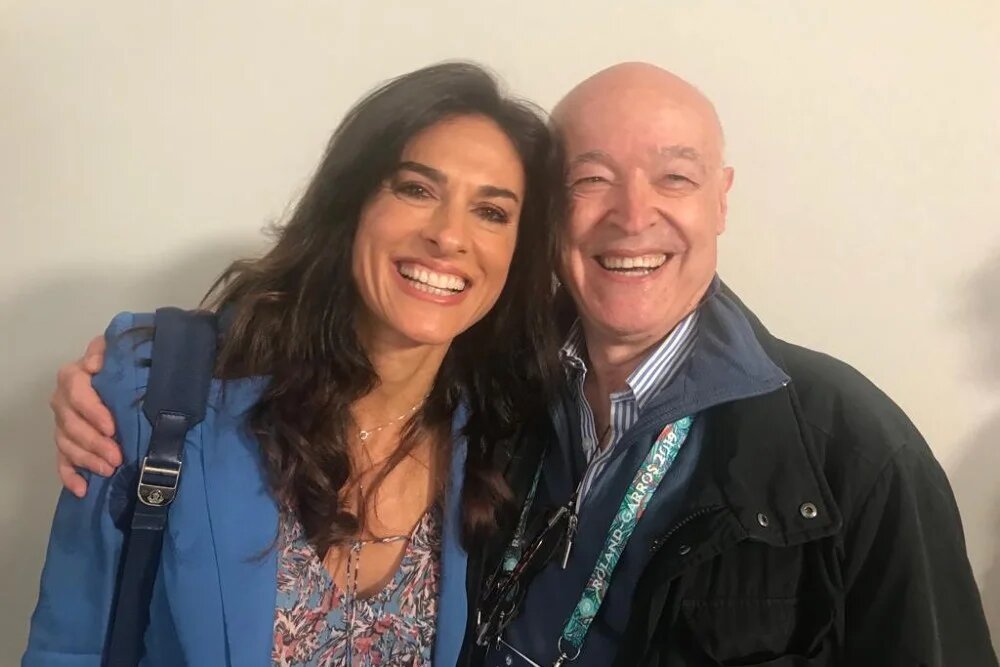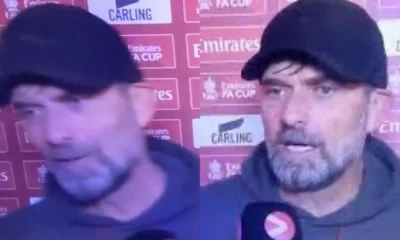Blog
How I “Discovered” Gabriela Sabatini And She Umpired One Of My Matches
 It seems impossible to me that Gabriela Sabatini is already turning 50. And also – go ahead and call me a sexist macho who gets diverted from the technical analysis of a player in order to dwell on her looks – it seems impossible to me that she can still as dazzling in her raven head. Actually, she might be even more beautiful than she was when she used to bewitch us with her magnificent one-handed stroke despite a bit of an androgynous gait, as if she’d just dismounted from her steed – she had built a broad pair of shoulders as well, in order to keep its harness in check.
It seems impossible to me that Gabriela Sabatini is already turning 50. And also – go ahead and call me a sexist macho who gets diverted from the technical analysis of a player in order to dwell on her looks – it seems impossible to me that she can still as dazzling in her raven head. Actually, she might be even more beautiful than she was when she used to bewitch us with her magnificent one-handed stroke despite a bit of an androgynous gait, as if she’d just dismounted from her steed – she had built a broad pair of shoulders as well, in order to keep its harness in check.
It just seems impossible because I heard about Gabriela when she wasn’t even 14, and I witnessed one of her matches when she was 14 and a month. From that day onwards I have always cherished her, while keeping a respectful distance. Firstly, because in some way I felt as if I’d discovered her (even if it isn’t true), and, secondly, because she is the only world-famous tennis player who’s ever sat on the umpire chair to officiate one of my matches in their entirety! Factor in the fact that she came into the world on May 16th (St. Ubaldo’s day), and it should become clear why I never forget about her birthday.
As I mentioned, Gabriela wasn’t even 14 when Guillermo Salatino, an Argentinian friend and colleague, called me from Buenos Aires: “My dear Ubaldo, I need you to do me a big favour. There’s a girl here with otherworldly talent, she is yet to turn 14 but I promise you she’s phenomenal. She really wants to play at Santa Croce [Editor’s Note: a junior tournament in Tuscany], but her ranking isn’t high enough to enter the draw, so she is going to need a wildcard to do it. Trust me, she’s 100% worth it!”
Personally, I utterly and completely trust Guillermo and his tennis savviness. Before he became a great journalist, a TV and radio broadcaster for ESPN South America, he was an excellent player, among the Top 20 of his country. Thus, I called the deus ex machina of the Santa Croce event, Mauro Sabatini, a man of extraordinary passion, without whom the tournament would have never seen the daylight. I asked him whether said wildcard could be given to Gabriela, telling him about Salatino’s forecast for her.
As I was trying to play the Italian-roots card (Her grandparents emigrated from Potenza Picena, in the province of Macerata…) he immediately stopped me: “My dear Ubaldo, could I ever deny entry to a player who shares my surname?” Then he erupted in laughter – a great man.
I’ll cut it short. Gabriela arrived in Tuscany in April, if I remember correctly, and dominated the event, winning an all-South American final – her Brazilian opponent, Dias, hardly had the same career though. Mauro Sabatini was so amazed he would have adopted her if he could! He thanked me every single time we met, even if I hadn’t done much – all I’d done, really, was asking him for a favour – but I have to say that Gabriela herself has thanked me more than once for that little push, even years later.
About a month later, Gabriela triumphed, under my curious gaze since I had not been present at Santa Croce, at a slightly more important junior event, none other than the French Open. At 14. Guillermo Salatino’s hunch was indisputably right, and it made me feel like a bit of a talent scout, albeit not at the same level as my peer’s. A couple years prior, so many of us were there, in Paris, in the press room of Court No.3 (which doesn’t exist anymore), marvelling at another wonderkid, a 12-year-old blondie, slender like reeds but with legs that were already long and a scary forehand – her name was Steffi Graf.
One-year Flash forward, to the April of 1985. Gabriela Sabatini was in Monte Carlo during the men’s tournament, which would be won by Ivan Lendl against Mats Wilander. I seem to recall that a junior event was taking place, either in the princedom itself or nearby on the Cote d’Azur.
As usual, the Country Club was hosting a tournament for journalists, and the final was between Guillermo Salatino and yours truly. The format was a single set to nine games. The winner’s prize was a trip to Botswana for two, paid for by a Monegasque travel agency, while the runner-up’s reward was an Ebel watch – a princely loot, as befits such a land.
That morning Gabriela showed up as well, delightful and incredibly sweet. The match wasn’t slated for the main court, obviously, but rather on one those terraced ones, up above the club. The closest and coziest seat was perhaps the umpire chair, and, for inexplicable reasons, it was Gabriela herself who ended up climbing it.
The match began. Gabriela, always shy but with a radiant smile, whispered the scores. I was appalling out of the gates: “3-0, señor Salatino!” As we switched sides, I told Guillermo: “Remember to send me a postcard from Botswana!”
“4-3 señor Scanagatta!” said Gabriela at even lower frequencies, but she looked like she was having a whale of a time, watching those two Over-35 blokes turn red like tomatoes while giving their all with their outdated game under the Monte Carlo sun.
“Ubaldo, you’re the one who’ll have to send that postcard,” panted Guillermo, to which I retorted: “I’d rather send it to Gabriela!”
We chugged along till the tie-break, at 8-8. I’m pretty sure I saved three match points at 6-8 down, but don’t hold me to that, and for sure I won’t be asking Gabriela for confirmation – and yet, somehow, I won.
Comes the denouement. I kept calling that shady travel agency for months, but it disappeared, bankrupting without fulfilling its due. Never been to Botswana, never sent any postcard. On the other hand, though, Guillermo flaunted his Ebel watch for years. A year later, to be fair, Bernard Noat, the then tournament director, gifted me with an Ebel too… and is to this day the favourite watch of my wife, Tiziana, whom I began to date the very same year.
About a month and a half after that unforgettable refereeing, Gabriela reached, at 15 years of age, the semifinals of the French Open, the youngest in the history of the tournament.
Other articles will dwell a little more on her sporting achievements, whereas I prefer to end on a further anecdote bonding the two of us. In 1990, I was sent for the first time to the Australian Open by the TV channel I worked for. A very humid and sticky heat, on Rebound Ace hardcourts that were a bona fide carnage for the players’ ankles, often sprained due to their owners’ shoes getting glued to the surface. Gabriela was among the victims, despite her N.2 seed, right behind Graf.
I had booked a TV one-on-one with her at the end of her third-round match. Gabriela had steamrolled past Frazier and Bollegraf, and was expected to do the same against Claudia Porwik, a German. Instead, she tripped during the opening set, and, despite getting promptly bandaged, there was little she could do, losing it with a score of 6-2 and retiring after a solitary game in the second set.
She left the centre court at Flinders Park – back then it was still called like that – on a wheelchair. Now, you tell me who else, man or woman, would have had the strength to show up in the press room after such an upset. But Gabriela showed up as if nothing had happened, and gave the interview she had promised. What an act of sportsmanship, and how amazingly educated had she been by her father Osvaldo – she’s just a fantastic person.
I took it badly when she retired at 26. I was distraught, because I thought it was happening far too soon, but her spark was extinguished. However, just like Bjorn Borg, another who had precariously retired at 26, Gabriela had already spent half her life, 13 years, fully immersed in professional tennis, breathing tennis, dreaming of tennis.
How could I not be fond of her, when, every time I’m lucky enough to run into her, she’s still so nice, so sweet, so caring? 50? I just cannot believe it.
-

 Blog3 months ago
Blog3 months agoThe next spy thriller starring Rami Malek has created a movie that is a competitor to Slow Horses Season 5.
-

 Blog5 months ago
Blog5 months agoGabriela Sabatini, la mejor tenista argentina de la historia, visible y Orgullosa
-

 Blog5 months ago
Blog5 months agoThere are seven quotes from Gabriela Sabatini that explain why she was so far away from the sport of tennis, her rivalries with Graf, and the players who are most admired by her at the present time.
-

 Manchester United11 months ago
Manchester United11 months agoMain reason Amad was sent off during Manchester United vs Liverpool FA Cup quarter-final match
-

 Liverpool11 months ago
Liverpool11 months agoFull Reason why 56-year-old Liverpool manager Jurgen Klopp angrily storms out of interview after Manchester United win vs Liverpool FA Cup quarter final
-

 Blog3 months ago
Blog3 months agoGeorge Russell breaks rank and follows Lewis Hamilton’s suit after Mercedes sack warning
-

 Blog5 months ago
Blog5 months agoQué dijo María Vázquez sobre Gabriela Sabatini tras conocerla en persona
-

 Blog5 months ago
Blog5 months agoRevelan quién es el verdadero amor de Gabriela Sabatini: conviven hace 15 años en Zurich
